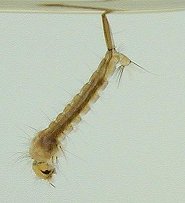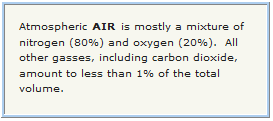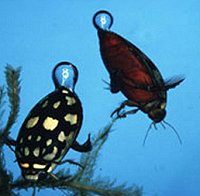Respiration in Aquatic Insects
Aquatic insects need oxygen too! They are equipped with a variety of adaptations that allow them to carry a supply of oxygen with them under water or to acquire it directly from their environment. Read each of the following sections to learn about these adaptations and how insects use them to obtain oxygen and maintain an aquatic lifestyle.
Cuticular Respiration
Many aquatic species have a relatively thin integument that is permeable to oxygen (and carbon dioxide). Diffusion of gasses through this body wall (cuticular respiration) may be sufficient to meet the metabolic demands of small, inactive insects — More about
Dissolved Oxygen especially those living in cold, fast-moving streams where there is plenty of dissolved oxygen. Larger insects, more active ones, or those living in less oxygenated water may need to rely on other adaptations (see below) to supplement cuticular respiration.
Biological Gills
 A biological gill is an organ that allows dissolved oxygen from the water to pass (by diffusion) into an organism’s body. In insects, gills are usually outgrowths of the tracheal system. They are covered by a thin layer of cuticle that is permeable to both oxygen and carbon dioxide.
A biological gill is an organ that allows dissolved oxygen from the water to pass (by diffusion) into an organism’s body. In insects, gills are usually outgrowths of the tracheal system. They are covered by a thin layer of cuticle that is permeable to both oxygen and carbon dioxide.
In mayflies and damselflies, the gills are leaf-like in shape and located on the sides or rear of the abdomen. Fanning movements of the gills keep them in contact with a constant supply of fresh water. Stoneflies and caddisflies have filamentous gills on the thorax or abdomen. Dragonflies differ from other aquatic insects by having internal gills associated with the rectum. Water is circulated in and out of the anus by muscular contractions of the abdomen. This rectal gill mechanism doubles as a jet propulsion system. A sudden, powerful contraction of the abdomen will expel a jet of water and thrust the insect forward — a quick way to escape from predators.

 Although many aquatic insects live underwater, they get air straight from the surface through hollow breathing tubes (sometimes called siphons) that work on the same principle as a diver’s snorkel. In mosquito larvae, for example, the siphon tube is an extension of the posterior spiracles. An opening at the end of the siphon is guarded by a ring of closely spaced hairs with a waterproof coating. At the air-water interface, these hairs break the surface tension of the water and maintain an open airway. When the insect dives, water pressure pushes the hairs close together so they seal off the opening and keep water out. Water scorpions (Hemiptera: Nepidae) and rat-tailed maggots (larvae of a syrphid fly) are two more examples of aquatic insects that have snorkel-like breathing tubes.
Although many aquatic insects live underwater, they get air straight from the surface through hollow breathing tubes (sometimes called siphons) that work on the same principle as a diver’s snorkel. In mosquito larvae, for example, the siphon tube is an extension of the posterior spiracles. An opening at the end of the siphon is guarded by a ring of closely spaced hairs with a waterproof coating. At the air-water interface, these hairs break the surface tension of the water and maintain an open airway. When the insect dives, water pressure pushes the hairs close together so they seal off the opening and keep water out. Water scorpions (Hemiptera: Nepidae) and rat-tailed maggots (larvae of a syrphid fly) are two more examples of aquatic insects that have snorkel-like breathing tubes. Some aquatic insects (diving beetles, for example) carry a bubble of air with them whenever they dive beneath the water surface. This bubble may be held under the elytra (wing covers) or it may be trapped against the body by specialized hairs. The bubble usually covers one or more spiracles so the insect can “breathe” air from the bubble while submerged.
Some aquatic insects (diving beetles, for example) carry a bubble of air with them whenever they dive beneath the water surface. This bubble may be held under the elytra (wing covers) or it may be trapped against the body by specialized hairs. The bubble usually covers one or more spiracles so the insect can “breathe” air from the bubble while submerged. An air bubble provides an insect with only a short-term supply of oxygen, but thanks to its unique physical properties, a bubble will also “collect” some of the oxygen molecules dissolved in the surrounding water. In effect, the bubble acts as a “physical gill” — replenishing its supply of oxygen through the physics of passive diffusion. The larger the surface area of the bubble, the more efficiently this system works. An insect can remain under water as long as the volume of oxygen diffusing into the bubble is greater than or equal to the volume of oxygen consumed by the insect. Unfortunately, the size of the bubble shrinks over time as nitrogen slowly diffuses out into the water. When the bubble’s surface area decreases, its rate of gas exchange also decreases. Eventually, the bubble becomes too small to keep up with metabolic demands and the insect must renew the entire bubble by returning to the water’s surface.
An air bubble provides an insect with only a short-term supply of oxygen, but thanks to its unique physical properties, a bubble will also “collect” some of the oxygen molecules dissolved in the surrounding water. In effect, the bubble acts as a “physical gill” — replenishing its supply of oxygen through the physics of passive diffusion. The larger the surface area of the bubble, the more efficiently this system works. An insect can remain under water as long as the volume of oxygen diffusing into the bubble is greater than or equal to the volume of oxygen consumed by the insect. Unfortunately, the size of the bubble shrinks over time as nitrogen slowly diffuses out into the water. When the bubble’s surface area decreases, its rate of gas exchange also decreases. Eventually, the bubble becomes too small to keep up with metabolic demands and the insect must renew the entire bubble by returning to the water’s surface. Hemoglobin is a respiratory pigment that facilitates the capture of oxygen molecules. It is an essential component of all human red blood cells, but it occurs only rarely in insects — most notably in the larvae of certain midges (family Chironomidae) known as bloodworms. These distinctive red “worms” usually live in the muddy depths of ponds or streams where dissolved oxygen may be in short supply. Under normal (aerobic) conditions, hemoglobin molecules in the blood bind and hold a reserve supply of oxygen. Whenever conditions become anaerobic, the oxygen is slowly released by the hemoglobin for use by the cells and tissues of the body. This back-up supply may only last a few minutes, but it’s usually long enough for the insect to move into more oxygenated water.
Hemoglobin is a respiratory pigment that facilitates the capture of oxygen molecules. It is an essential component of all human red blood cells, but it occurs only rarely in insects — most notably in the larvae of certain midges (family Chironomidae) known as bloodworms. These distinctive red “worms” usually live in the muddy depths of ponds or streams where dissolved oxygen may be in short supply. Under normal (aerobic) conditions, hemoglobin molecules in the blood bind and hold a reserve supply of oxygen. Whenever conditions become anaerobic, the oxygen is slowly released by the hemoglobin for use by the cells and tissues of the body. This back-up supply may only last a few minutes, but it’s usually long enough for the insect to move into more oxygenated water.